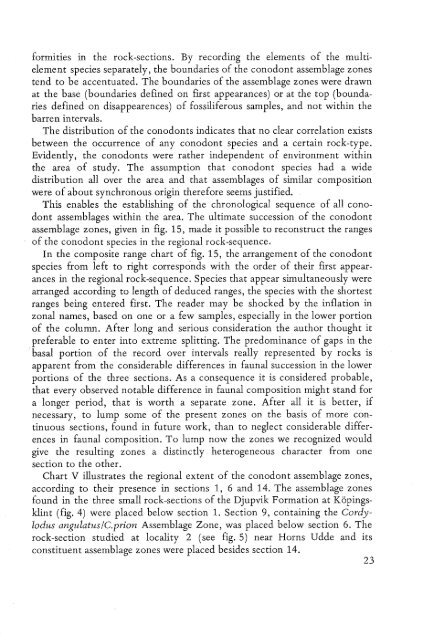UTRECHT MICROPALEONTOLOGICAL BUllETINS
UTRECHT MICROPALEONTOLOGICAL BUllETINS
UTRECHT MICROPALEONTOLOGICAL BUllETINS
Create successful ePaper yourself
Turn your PDF publications into a flip-book with our unique Google optimized e-Paper software.
formities in the rock-sections. By recording the elements of the multielement<br />
species separately, the boundaries of the conodont assemblage zones<br />
tend to be accentuated. The boundaries of the assemblage zones were drawn<br />
at the base (boundaries defined on first appearances) or at the top (boundaries<br />
defined on disappearences) of fossiliferous samples, and not within the<br />
barren intervals.<br />
The distribution of the conodonts indicates that no clear correlation exists<br />
between the occurrence of any conodont species and a certain rock-type.<br />
Evidently, the conodonts were rather independent of environment within<br />
the area of study. The assumption that conodont species had a wide<br />
distribution allover the area and that assemblages of similar composition<br />
were of about synchronous origin therefore seems justified.<br />
This enables the establishing of the chronological sequence of all conodont<br />
assemblages within the area. The ultimate succession of the conodont<br />
assemblage zones, given in fig. 15, made it possible to reconstruct the ranges<br />
of the conodont species in the regional rock-sequence.<br />
In the composite range chart of fig. 15, the arrangement of the conodont<br />
species from left to right corresponds with the order of their first appearances<br />
in the regional rock-sequence. Species that appear simultaneously were<br />
arranged according to length of deduced ranges, the species with the shortest<br />
ranges being entered first. The reader may be shocked by the inflation in<br />
zonal names, based on one or a few samples, especially in the lower portion<br />
of the column. After long and serious consideration the author thought it<br />
preferable to enter into extreme splitting. The predominance of gaps in the<br />
basal portion of the record over intervals really represented by rocks is<br />
apparent from the considerable differences in faunal succession in the lower<br />
portions of the three sections. As a consequence it is considered probable,<br />
that every observed notable difference in faunal composition might stand for<br />
a longer period, that is worth a separate zone. After all it is better, if<br />
necessary, to lump some of the present zones on the basis of more continuous<br />
sections, found in future work, than to neglect considerable differences<br />
in faunal composition. To lump now the zones we recognized would<br />
give the resulting zones a distinctly heterogeneous character from one<br />
section to the other.<br />
Chart V illustrates the regional extent of the conodont assemblage zones,<br />
according to their presence in sections 1, 6 and 14. The assemblage zones<br />
found in the three small rock-sections of the Djupvik Formation at Kopingsklint<br />
(fig. 4) were placed below section 1. Section 9, containing the Cordylodus<br />
angulatus/G.prion Assemblage Zone, was placed below section 6. The<br />
rock-section studied at locality 2 (see fig. 5) near Horns Udde and its<br />
constituent assemblage zones were placed besides section 14.
















